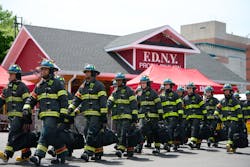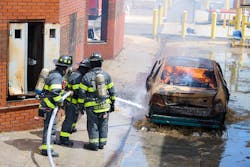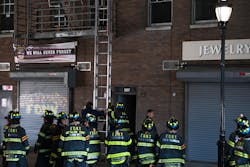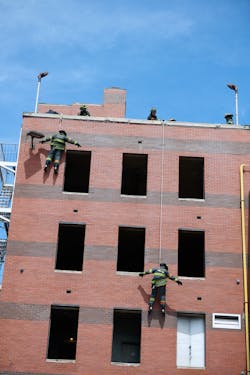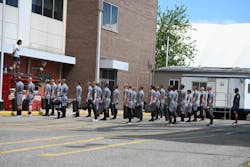Training and educating the members of FDNY is an awesome responsibility and one that I don’t take lightly. I am truly blessed and honored to be entrusted with it. Training provides the cornerstone of every fire department: As your training goes, so goes the success or failure of your department.
Furthermore, training isn’t static. It’s dynamic. Simply stated, you’re either getting better or getting worse: If you’re training, you’re getting better; if you aren’t training—start!
FDNY training chief
We are able to mentor and inspire our next generations of leaders—and help to ensure long-term sustainability of our department—when we provide a greater understanding of our job responsibilities. Most firefighters understand the role of a lieutenant, captain or battalion chief but might not understand the roles that take on a more administrative function. This article provides a glimpse into the typical week of an FDNY training chief.
Monday: Headquarters
Although my office is at the fire academy on Randall’s Island, we begin this day at headquarters for several meetings. I say “we” because my driver, Joe, is with me. Joe is an experienced firefighter who has many years on the job. He is trustworthy and a great sounding board for me.
I typically am very productive when I am in the car, which is good, because, some days, we spend many hours driving.
I make a quick phone call to my team that produces our “Tip from Training” bulletins. The single-page bulletins educate and inform members about incidents and/or close calls from around the city using a short narrative of the incident followed by bullet points. (In 2021, we issued 119 of these bulletins.) Sometimes, we are able to release these documents while units still are on scene. This day, we discuss a close call that a unit had while it operated at a motor-vehicle accident on the highway overnight. Our members’ proper operation on the highway prevented them from being struck by a drunk driver. Sometimes, the moments that don’t happen matter the most—and show why consistent training prevents many tragic occurrences.At headquarters, the weekly meeting of the department bureau heads is first. It provides the chief of department the opportunity to drill down on specific issues in each of the bureaus. This isn’t possible during the staff meeting because of the number of attendees.
I attend this meeting to represent the fire and EMS academies. This is an opportunity to advocate for training: update the chief of department, introduce new initiatives and seek approval or make a request for assistance when needed. New ideas are presented to put them “on the radar” of the chief of department.
An informal meeting with the chief of safety is next. Training and safety often work together. We have a great working relationship and discuss several recent fires.
In the afternoon, I stop for short meetings with our grant-writing team, at the office of our legal team and at the budget office. An often underappreciated fact is the pride that these professionals—in addition to the uniformed members—have working for FDNY.
When it comes down to it, the training chief is the head cheerleader and advocate for continual training and improvement. Indeed, I spend a good number of hours each week operating in this role. Decades of past training chiefs set the bar extremely high. However, I have witnessed that other departments don’t understand fully the importance of the training chief to set the tone, tempo and culture of training.
Simply stated, when training isn’t prioritized, funded and advocated, you eventually will pay the bill. This cost for a lack of training always is higher than the cost of continual training and often is paid back in civilian and firefighter injuries and, sometimes, deaths.Tuesday: Fort Totten
On the way to the fire academy, we stop at a firehouse in Queens (Engine 260) for coffee and to discuss a fire that they had the previous night. They did a great job of locating the fire and implementing a long stretch.
The fire was in a duplex apartment, which was why I wanted to stop in. I needed information on this fire for a “Tip from Training” on this construction’s unique features. This fire was in a duplex up, or the level above the main entrance that the members entered.
The crew that worked the fire was into the job and knowledgeable. We had a great conversation discussing this fire and other topics too. I was happy to see previous issues of “Tip from Training” hung on the wall in the kitchen.
I arrive at the fire academy just in time to speak to the attendees of that day’s Annual Education Day. This is one of my favorite parts of the day, because it gives me an opportunity to speak directly to field units.
Our firefighters are scheduled for a day of training at the fire academy on an annual basis. Of course, this is in addition to the many other training opportunities that they are afforded. Each day, a time slot is allotted to the chief of the fire academy or the chief of training to speak to the firefighters and fire officers in attendance. After providing them with an update of important department initiatives and details about ongoing training programs, the floor is opened up for questions. Often, a good discussion on tactics ensues. Sometimes, clarification of a new policy is needed. Whatever the topic, these interactions are vitally important. After all, we are there to facilitate and support the operators in the field, and this is an excellent opportunity to listen to the concerns of our firefighters.
Next, I meet with my video production team to discuss new training videos. They are a dedicated bunch that has a great deal of video production talent as well as fire service experience, which produces high-quality, information-packed training videos.
The meeting starts with a review of recently completed engine videos. We then discuss the final edits on a series of videos that’s aimed to bring greater awareness on how firefighters can reduce their risk of occupational cancer.
My Remote Tactical Training Unit (RTTU) resides in the same building. The members of the unit are preparing for the day’s live training segment. Trainings are broadcast to firehouses Monday through Thursday at 10:30 a.m. and 11:30 a.m.. They typically cover the same topic for an entire month to ensure that most members who want to see the training have an opportunity to do so.
The training usually lasts 15–20 minutes and often features a senior member of the department as the lead instructor of the day.
This is a new training tool in FDNY that started during the early part of the pandemic to ensure that training continued regardless of the obstacles. It has been a great addition and is an excellent supplement to hands-on training. On a typical morning, 30–50 companies log on to watch a training, equaling more than 100 firefighters.
I try to find the time to watch at least one of the remote tactical training segments per week—although sometimes I watch on a “day off.” I learn from my people every time I tune in and listen. I am appreciative of their dedication to the FDNY and their craft.
After lunch, we make our way to Queens to stop at our EMS academy and our First Line Supervisors course. Both are located at Fort Totten. I receive updates on the courses that are in progress.
FDNY is fortunate to have world-class, dedicated instructors at the fire and EMS academies. They enable our collective successes and are the strength of the bureau of training. The successes occur every single day on fire and EMS responses throughout New York City. Training is the foundation upon which our organization is built.
Wednesday: Fire Academy
At the fire academy, the monthly meeting of unit heads is conducted by the chief of the fire academy. The meeting affords the units that operate out of the fire academy the opportunity to inform and update the leadership of the fire academy and of training, as well as the other units at the fire academy, on the status and progress of training and other initiatives. It’s an impressive meeting, with every unit always working to raise the bar of training in the FDNY. Whether it regards new curriculum development, a new tool document, working with the bureau of safety to pilot new equipment, collaborating with an outside organization to train and educate members, training often has a seat at the table and is involved in all aspects of the fire department.
The meeting begins at 8:00 a.m. in an attempt to conclude by 9:00 a.m., before line units arrive to begin training. However, following the meeting, smaller meetings and conversations take place, as ideas and initiatives are further fleshed out.
The duration of the meeting leaves me enough time to speak to the Annual Education Day firefighters and to watch the remote tactical drill at 11:30 a.m.
Next up is a virtual NFPA meeting. (I sit on three committees.) Before the pandemic, meetings were held in person. For the past two years, they have been held remotely. These virtual meetings aren’t ideal, but we manage to get the job done.
This day, the meeting (three hours) is on NFPA 1585: Standard on Contamination Control.
FDNY members sit on dozens of NFPA committees, including several members who represent the bureau of training.Thursday: Meetings
An early morning meeting to discuss planned upgrades at both the EMS and fire academies kicks off the day.
In the past two years, my project manager, Paul, working with facilities, has done a remarkable job of helping the bureau of training upgrade its training academies to optimize and modernize training. This is particularly evident as we continue to integrate greater use of technology into training (prompted by the start of the pandemic), including our newly installed cell site.
The bureau of training’s many moving parts and projects need so much attention that we require a dedicated project manager, who works directly for and with the bureau of training. This takes these projects off of my plate, which allows me to focus more on training and less on the infrastructure that supports training.
Next up: A staff meeting at headquarters. It’s conducted by either the chief of department or the fire commissioner. It’s attended by the staff positions of the fire department, such as the chiefs of fire and EMS operations, personnel, fire prevention, training, safety, fire investigations, and fire and EMS academies, as well as borough commanders from both fire and EMS.
The meeting, which often is held every other week, provides an opportunity for the top leadership of the department to ensure that their leaders’ intent is delivered, understood and, when required, implemented.
Typically, these are high-level discussions. It’s common to hear an update on a revised medical protocol from EMS leadership; apparatus collisions from safety; new city hall initiatives from operations; fire code enforcement from fire prevention; a fire investigation from the chief fire marshal; community event planning, such as a parade, from the chief of planning; and the progress of the training of both EMS and fire probies.
Just before noon while heading back to the fire academy, we make a quick visit to the “Elmhurst Eagles”—Engine 287, Ladder 136 and Battalion 46—to speak to the on-duty battalion chief, Tim Keenan. He heads up a training initiative regarding a fire dynamics prop. This provides a good excuse to get a face-to-face update.
I was a battalion chief in this busy firehouse, so I always am welcomed by many familiar faces. The next thing you know, everyone is drilling in the kitchen.
The firefighters invite us to stay for lunch. We happily agree to stay. I don’t get many opportunities for a firehouse meal these days. However, I am mindful of my busy afternoon, and we leave right after eating and head to the fire academy.
In the afternoon, I have meetings scheduled with our tactical unit and probie school. Both units are highly dedicated to the success of training.
Friday: Citywide
This day, I am working a citywide tour. These are 24-hour tours that begin at 8:00 a.m. I enjoy these tours, because they provide an opportunity to respond to fires and emergencies around the city. Typically, when citywide, you respond only to serious fires—either a second- or third-alarm, depending on the building type.
Most often, I am scheduled for a citywide once every two weeks. However, I sometimes pick up open tours. Not all staff chiefs work citywide tours, because there’s a tiered response when certain chief positions have response requirements on higher alarms.
During citywide tours, you’re responsible for the operation and administration of the fire department. During the week, when the borough commands are working (all five boroughs have a commander who also is a staff chief), they cover their borough during the day until 4:00 p.m., when they go off duty. This day, they all are working and covering their assigned borough, so I will cover the city beginning at 4:00 p.m. and be in command until relieved at 8:00 a.m. Saturday morning.
I begin my day with a phone call from the Fire Department Operations Center (FDOC). They provide me with intel of events and activities that are planned around the city. New York City is a city that never sleeps, and this intel usually demonstrates this truth.
Following the phone call, I review the riding list (who is working) of each division and battalion. This is important information, because I like to gauge the experience level of each commander. This is part of my preplanning for the day. Weather and other response and operational considerations also are accounted for and discussed with my driver as we head to the fire academy.
I have time before lunch, so I use it to catch up with my staff.
In the afternoon, I have time to answer emails and catch up on projects that require my attention.
I receive a call from FDOC. They let me know about a multiple-alarm fire in Manhattan. However, because it’s before 4:00 p.m., it’s just a notification that the Manhattan borough command is responding.
Late in the afternoon at the fire academy, there isn’t much activity, although the probies are there running evolutions. I see them from the elliptical in front of the window in the gym as I get in a quick one-hour cardio workout.
At 6:00 p.m., there’s time to visit firehouses and talk to the firefighters. We plan a visit for a drill at the firehouse where I was a captain, Engine 76. The brothers and sisters always welcome me there, and they urge me to stay for dinner, but we already stopped for pizza (at Koronet Pizza, home of “The BIG Slice,” which is only a few blocks away; not only does one slice fill the bill, but it’s tasty, too.)
After drill, we return to the fire academy to clear up a few more emails, but that doesn’t last long.
Shortly before 9:00 p.m., a third-alarm is transmitted for a taxpayer fire in the Bronx. Truth be told, I already was monitoring the fire via the Citizen app and the dispatcher transmissions, so I had been getting ready to go.
The Citizen app uses crowdsourcing to allow anyone to share video of fire scenes. This is a tremendous size-up tool for me. A serious fire might have dozens of videos available to view. I scroll through them all to look for a tactical and strategic advantage.
On the way to the fire, even more information is at my disposal, including via the Incident Command app and Handie-Talkie transmissions from the scene—all of which I am able to concentrate on because of Joe. Having a driver frees my mind to think about the strategies and tactics that already are employed on scene before my arrival.
Joe and I briefly discuss the information that we are receiving.
Our response is relatively quick. We announce our arrival to the Bronx dispatcher, and I head to the command post.
I arrive with a set of objectives and expectations about command and control and strategies and tactics for this expanding fire.
As expected, the deputy chief and the first battalion chief are running the fire. Although the scene is chaotic, they are calm and doing an exceptional job.
I run through the objectives and expectations that I had in mind and am very happy that the incident commander (IC) already implemented these same objectives. We are fortunate that our ICs are so experienced.
Aside from establishing a few sectors, the IC continues to run the fire. I serve more in an advisory capacity, and the fire soon is under control.
I head to headquarters, where I will spend the rest of the night. The remainder of the night is relatively quiet, aside from a few administrative matters and a few all-hands fires that don’t require my response.
At 8:00 a.m. Saturday morning, this productive week draws to a close.
About the Author
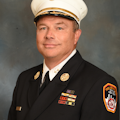
Frank Leeb
Frank Leeb is the managing director of the First Responder Center for Excellence. He previously served as a deputy assistant chief in FDNY, retiring in June 2024 after more than 31 years. During his tenure with FDNY, Leeb held several senior staff positions, including chief of the fire academy, chief of training and chief of safety. He also has been a member of the East Farmingdale, NY, Volunteer Fire Department since 1983. Leeb holds a bachelor's degree in fire service administration from SUNY Empire State and a master’s degree in security studies from the Naval Postgraduate School, Center for Homeland Defense and Security. He served as an advisory panel member for UL's Fire Safety Research Institute's "Study of Coordinated Fire Attack Utilizing Acquired Structures" and was the keynote speaker for Firehouse Expo in 2022 and FireFusion 2024. Leeb is the author of "Cornerstones of Leadership: On and Off the Fireground." He was a presenter at the 2022 and 2023 U.S. Fire Administrator Summit on Fire Prevention and Control. Leeb can be contacted at [email protected].
